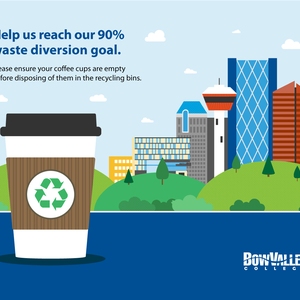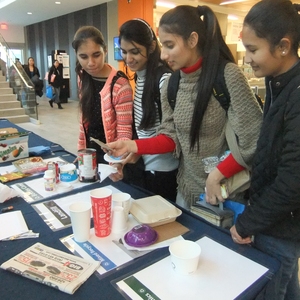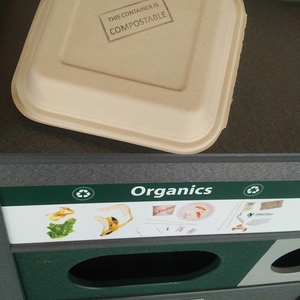Progress toward 90% waste diversion goal
Olds College, Bow Valley College
Project Overview
Bow Valley College has come a long way in terms of waste management in the past four years. In 2014, our waste diversion rate was 19%. In 2018, our diversion rate has jumped to 76%, due to traditional recycling and composting programs, and special programs for fabric, plastic gloves, batteries, pens, IV bags, cooking oil, and electronics recycling. We continue to strive for larger diversion, with the goal of 90% diversion by 2020. With only a part-time staff position dedicated to sustainability, this initiative was only possible through inter-departmental collaborations.
Background
In 2016, a recycling bylaw came into effect for the city of Calgary. This was followed by mandatory composting programs for all institutions in 2017. In response to this bylaw, Bow Valley College implemented four-stream waste stations around the college (landfill, organics, mixed recycling, and bottles & cans) and removed all individual garbage cans across the college. Once we saw our diversion rate skyrocket, we wanted to continue and get as close to zero-waste as possible.
Goals
Our 2018 waste assessment determined 97% of our waste could be recycled or composted. So, we think our goal to reach 90% diversion by 2020 is reasonable, albeit difficult. We are on our way to meeting this goal at 76% in 2018. In order to fully reach this goal, we will need to implement more creative programs and focus on food waste reduction and prevention strategies.
At time of writing, we are waiting for our sustainable procurement policy to pass at the Executive level. This policy will embed stringent waste reduction practices in all of our purchasing decisions, reducing the waste the college produces overall. We also have the goal to meaningfully engage the campus community on the program, and keep them up to date on our progress toward the 90% goal.
Implementation
Although the waste diversion strategies are driven by the Sustainability Coordinator, it is only made possible by collaboration between the Facilities Management team, Olds College, Library, Students’ Association, and Sodexo Canada.
In 2016, all individual garbage cans were removed across the college by BVC Green team volunteers (staff and students). Now, all members of the campus community must walk to the closest sorting station to dispose of their waste. All waste stations are identical across the college, and match the colours of the municipal waste programs (blue = recycling, green = organics, black = landfill). All signs contain pictures for ease of sorting, and the landfill container is the smallest, to encourage the use of the recycling and compost bins. The bottles and cans that we collect are donated to a local nonprofit, Vecova, which supports people with disabilities. Once this four-stream program was in place, we began focusing on non-traditional waste that could be diverted through special programs.
Olds College leases space from Bow Valley College. Olds College Fashion Institute and Bow Valley College School of Creative Technologies partnered to send their fabric scraps to the Calgary Drop-in Centre for sorting, reuse, and recycling. Plastic gloves from all food services areas are collected and recycled through TerraCycle. Batteries and pens are collected in bins in each of the office areas and recycled through Call2Recycle and Staples Canada, respectively. In fall 2017, the Library and Students Association hosted bins for a battery and pen recycling drive, so students could recycle these items as well. The bins were so popular, that both spaces asked for a permanent bin.
An arrangement was made between Sodexo Canada and a local citizen. This Calgarian picks up Sodexo’s used cooking oil from the college each week, and converts it into biofuel for his biofuel car. We donate uneaten and unopened food to Leftovers YYC, a local nonprofit that redistributes food to those in need.
Sodexo also took the lead on banning straws from their food areas, and charging 5 cents for a plastic bag. As Calgary currently does not have a ban or disincentive program for single-use plastic, this is an example of waste prevention leadership. The Bow Valley College Board of Governors introduced paperless Board packages in 2017 to reduce paper waste. All computers at the college are set to double-sided black and white printing.
We encourage members of the campus community to reuse, and run a deposit program on reusable containers called Choose-to-Reuse. Additionally, all hot drinks bought in a reusable cup receive a discount.
Throughout the process, we have kept the campus community apprised of our progress toward our 90% diversion goal. At each New Student Orientation we run an interactive waste sorting game during the lunch hour. We have also done in-class presentations on recycling, and recently introduced a ‘green reminder’ screen saver for all staff computers as a reminder to recycle coffee cups. A presentation on the waste diversion programs was made at the 2017 College-wide staff meeting.
Timeline
It took us 3.5 years to get from a diversion rate of 19% to 76%:
November 2014: waste assessment conducted
January 2015 – July 2016: Sustainability Coordinator hired, research & development
August 2016: 4-stream waste program is introduced; all individual garbage cans are removed
October 2016: Choose-to-Reuse program introduced
January 2017: fabric, pen, battery, and plastic glove recycling programs are introduced; paperless Board packages introduced
June 2017: discount introduced for all hot drinks served in reusable mugs
July 2017: draft sustainability policy (containing section on sustainable procurement) submitted to Executive team for approval
October 2017: battery & pen recycling drive; presentation to all staff at College-wide meeting day
February 2018: waste assessment conducted
March 2018: campus cafeteria bans straws
April 2018: campus cafeteria begins charging 5 cents for plastic bags
Financing
The staff time and funding for waste bins and waste assessments have all come out of our Facilities operating budget. The Choose-to-Reuse program was funded through a TD Friends of the Environment Foundation grant, and with support from the Students’ Association. The costs associated with the program included buying the reusable CTR containers, deposit cards, and marketing materials.
Results
We have engaged with all staff, and 424 students directly over the course of this project.
We recycled 112 000 plastic gloves, 3236 batteries, 1640 pens, and 23 000 litres of cooking oil in 2017.
900 food items were donated to Leftovers YYC in 2017 and diverted from landfill
By going strawless, we will keep an estimated 10 000 straws out of landfill each year
5997 reusable mugs were used on campus in 2017
The Ecoprint function has saved the equivalent of 1300 trees
Our current waste diversion rate is 76%
We have an active and engaged BVC Green team that is always coming up with new ways to educate about waste diversion on campus. Our next project is to create short videos we can share with staff and students highlighting our ‘trickiest’ items for sorting.
Lessons Learned
A) This diversion rate was only possible by removing individual garbage cans from offices and shared spaces. The project was about increasing our waste diversion rate, but also about fostering more sustainable behaviour. By sharing waste stations, our custodial team is now much more efficient, and staff must take more frequent walking breaks away from their desk. However, this is also been the hardest part to justify to staff! We found by highlighting the difference that decision made (19% diversion to 76%) has been effective in convincing those that were intially opposed.
B) If we were designing the bins again, we would not separate out the bottles and cans from the mixed recycling. Instead, we would stick with a 3-stream system, similar to the rest of the city. The fourth bin often confuses people, so we end up with some contamination in our bottle and can stream.
C) Succession planning can be difficult, and as new people enter the college, they must be trained intentionally. For example, recently our partner for our fabric recycling program at Olds College left, and we spent several weeks trying to connect with the new employee. Programs do not sustain on their own – they always need an active supporter.



